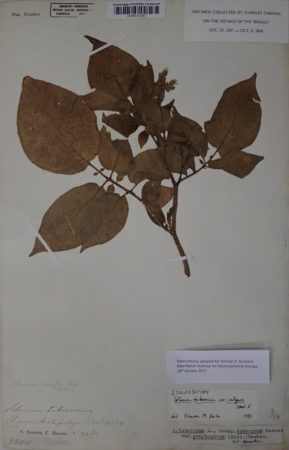- Greek organic farm resists.
- Communities getting into seed banking all over.
- Saving zapalote chico.
- Would you like chiltepines with that?
- No zapalote chico in South Africa, but lots of other maize.
- Conserving agricultural biodiversity in China.
- Including in Hainan.
- At the same time, China restricts foreign access to human genome data.
- Sexually plastic Australian wild tomato named at long last.
- Breeding flavour crops.
- And figuring out how much it will cost.
- Interesting project on human-chicken interactions.
- Veggie breeder wins World Food Prize.
- New coffee table book on cattle in Africa.
- Flagship agroforestry database gets new version. Anyone wanna test it for us?
- Minor cereals in Europe are anything but minor.
- And lots are conserved in Europe’s increasingly scrutinized genebanks.
- Meanwhile, a major cereals keeps getting the attention it also needs.
- “The candidate markers could be used by any rice genebank to potentially identify varieties with seeds that are particularly short- or long-lived in storage. Viability monitoring intervals could then be customized by variety.” And wheat?
European spud history unthreaded

I could blog about the recent paper which used sequencing of old herbarium specimens, including this one collected by Darwin to trace the genetic history of potatoes in Europe. But I think I’ll let one of the authors do it instead, here.
If you don’t like Twitter, you can see the thread unspooled without going anywhere near it.
Brainfood: Macadamia domestication, Middle Eastern wheat, ART virus, Open science, Red Queen, Food system change, Chinese Neolithic booze, Dough rings, Making maps, Biofortification, Endophytes, African maize, Switchgrass diversity, Ancestral legume
- Wild Origins of Macadamia Domestication Identified Through Intraspecific Chloroplast Genome Sequencing. One tree is the basis of the industry.
- The Israeli Palestinian wheat landraces collection: restoration and characterization of lost genetic diversity. Bringing it all back home.
- Using high‐throughput sequencing in support of a plant health outbreak reveals novel viruses in Ullucus tuberosus (Basellaceae). There’s always something…
- Plant health emergencies demand open science: Tackling a cereal killer on the run. …but openness will get us through it.
- Rapid evolution in plant–microbe interactions – a molecular genomics perspective. Until the next one.
- Understanding food systems drivers: A critical review of the literature. Spoiler alert: urbanization, raise in consumer income, population growth, attention paid to diet & health issues, technological innovations, intensification and homogenization of the agricultural sector, increase in frequency and intensity of extreme events, general degradation in soils and agro-ecological conditions, improved access to infrastructure and information, trade policies and other processes influencing trade expansion, internationalization of private investments, concerns for food safety. I guess diversity is in there somewhere.
- The origins of specialized pottery and diverse alcohol fermentation techniques in Early Neolithic China. So good, they invented fermentation twice.
- The Hoard of the Rings. “Odd” annular bread-like objects as a case study for cereal-product diversity at the Late Bronze Age hillfort site of Stillfried (Lower Austria). Unbaked, tarallini-like dried wheat/barley dough rings may have been used ritualistically. No, not like that.
- EviAtlas: a tool for visualising evidence synthesis databases. Everybody likes a map.
- Editorial: Improving the Nutritional Content and Quality of Crops: Promises, Achievements, and Future Challenges. A review of reviews of biofortification, and more.
- Fungal endophyte diversity from tropical forage grass Brachiaria. 38 fungi isolated from 9 Brachiaria species, but unclear if any are beneficial.
- Characteristics of maize cultivars in Africa: How modern are they and how many do smallholder farmers grow? Out of 500 samples in 13 countries, about half were in some way improved, covering about half of the surveyed planted area.
- QTL × environment interactions underlie adaptive divergence in switchgrass across a large latitudinal gradient. You can combine alleles which are locally advantageous in different places to get a
super-biofuel. - Reconstruction of ancestral genome reveals chromosome evolution history for selected legume species. The wild ancestor of peanut, pigeonpea, soybean, beans, mungbean, chickpea, lotus and medics was closest to wild peanuts. Maybe they can synthesize it?
New Vavilov movie in the multiplex
The Scientist, the Imposter and Stalin: How to Feed the People is a new film on Vavilov by Gulya Mirzoeva. It looks like it can be ordered from Icarus Films.
Made entirely with previously unreleased archival footage, THE SCIENTIST, THE IMPOSTER AND STALIN offers a rare immediacy to events that took place decades ago. It is both an engrossing story and a warning about the disastrous results of yoking science to politics.
Here’s the teaser. 1
Nibbles: Coffee science, Bob Marley’s weed, Diversity video, CIP genebank, Cornell potatoes, Fiji hibiscus, Cereal festival, Organic breeding, British Neolithic, Wheat & CC, Celery history
- The Coffee Science Foundation is the science foundation we all need.
- In search of Bob’s ganja.
- Vox vid on saving crop diversity. Pretty good, except for that thorn apple thing.
- GIZ support for the CIP genebank.
- Ex-CIP breeder works with VIR to bring wild potatoes to Cornell.
- Or friend Lex Thomson on why Fiji is a hibiscus hotspot.
- Celebrate European cereal diversity.
- Dan Barber on freeing the seed. The polarisation continues.
- The first British farmers walked there.
- CIMMYT rebuttal of a paper saying European wheat varieties are decreasing in their climate resilience.
- Celery was once a luxury.